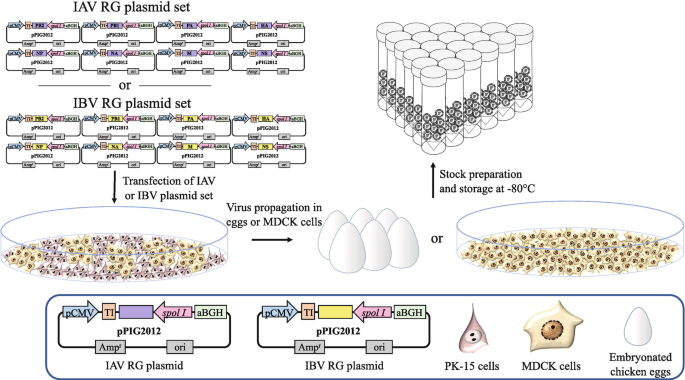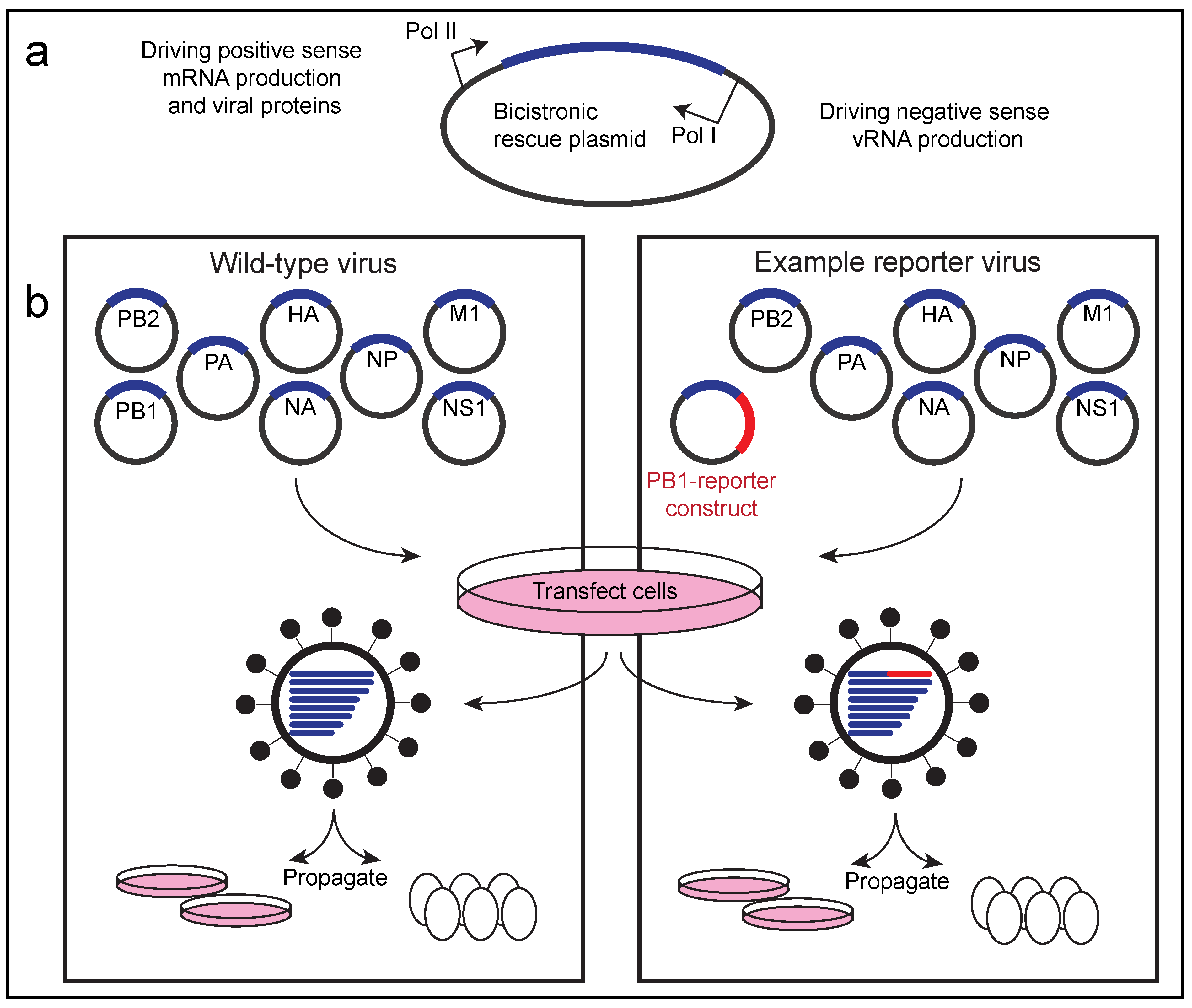reverse genetics influenza
This technology involved the transfection of in vitro-reconstituted ribonucleoprotein RNP complexes into influenza virus-infected cells. The varied applications of the technology as well as current trends such as 2A self-cleaving peptides for coexpression of foreign genes are also outlined.

Reverse Genetics For Influenza A And B Viruses Driven By Swine Polymerase I Promoter Springerlink
Reverse genetics is the creation of a virus from a full-length cDNA copy of the viral genome referred to as an infectious clone and is one of the most powerful genetic tools in.

. The reverse genetics RG system of influenza A viruses is well established. Reverse genetics has been used to generate an effective commercially available LAIV FluMist Ref. For this purpose we chose the X-31.
The process proceeds in the opposite direction to forward genetic screens of classical genetics. While forward genetics seeks to find the genetic basis of. Use of reverse genetics to develop universal influenza vaccines.
We have now developed a method that allows intracellular reconstitution of RNP complexes from. Since 1999 plasmid-based reverse genetics RG systems have revolutionized the way influenza viruses are studied. 39 that is delivered as a nasal spray and has been licensed for use in the USA since 2003 Ref.
Reverse genetics is a method in molecular genetics that is used to help understand the function of a gene by analysing the phenotypic effects caused by genetically engineering specific nucleic acid sequences within the gene. Viruses either by transfecting cells with plasmids encoding the viral genome or by heterologous recombination of plasmids bearing viral sequences with the virus genome 12. However the conventional sequence-dependent method for cloning influenza genome segments is time-consuming and requires.
Influenza B virus reverse genetic backbones with improved growth properties in the EB66 cell line as basis for vaccine seed virus generation. IAV reverse genetics technologies that allow the generation of recombinant viruses from complementary cDNAs have transformed the field and have made possible the study of the underlying mechanisms of viral pathogenicity transmission or interaction with host factors to expand our knowledge of IAV infections 6. 40 and in the European Union since 2011 as Fluenz Ref.
Reverse genetics of negative-sense RNA viruses which enables one to generate virus entirely from cloned cDNA has progressed rapidly over the past. RG manipulations were performed first using DNA viruses and then using RNA viruses. USA 96 9345-9350 and others Fodor.
Reverse genetics RG is an essential tool to dissect the biological features of viruses in vivo and in vitro. The artificial generation of influenza viruses from cloned cDNA was long considered an insurmountable obstacle but this changed in 1999 with the establishment of plasmid-based reverse genetics for influenza virus generation. However it is not unusual to encounter cloning difficulties for one or more influenza genes while attempting to recover virus de novo.
This reverse genetics system will become a powerful tool for use in studies related to understanding the molecular mechanisms of viral replication and pathogenicity and will also lead to the development of. The poliovirus was the first positive sense RNA virus to be manipulated by RG 4041. A reverse genetics system for negative-strand RNA viruses was first successfully developed for influenza viruses.
However the process is not flawless and difficulties remain during cloning of influenza gene segments into reverse genetics vectors pHW2000 pHH21 pCAGGS. Reverse genetics is an experimental molecular genetics technique that enables researchers to elucidate gene function by examining changes to phenotypes of cells or organisms caused by genetically. García-Sastre Biology Vaccine 2018 8 PDF Cold adaptation generates mutations associated with the growth of influenza B vaccine viruses.
Reverse genetics is used in many laboratories around the world and enables the creation of tailor-made influenza viruses with a desired genotype or phenotype. Here we extended and adopted the cDNA based reverse genetic system to generate both injectable and nasal spray type live attenuated influenza vaccine LAIV. Although influenza virus was the first negative-strand RNA virus to have individual virus genes replaced by artificially manipulated segments the difficulty in dealing with a segmented RNA genome as well as the use of labor-intensive and selection-dependent techniques to drive reverse genetics has hindered the application of this technology.
Reverse Genetics Systems for Negative-Sense RNA Viruses. This review summarizes major technical breakthroughs in the development of reverse genetics technologies for negative-sense RNA viruses using Influenza A Virus IAV as a model system. Reverse genetics for influenza B virus.
Reverse genetics is the creation of a virus from a full-length cDNA copy of the viral genome referred to as an infectious clone and is one of the most powerful genetic tools in modern virology. Here we developed a reverse genetics system that allows for the generation of IDV from cloned cDNAs and the introduction of mutations into the IDV genome. The influenza B virus gene segments were cloned by reverse transcription-PCR RT-PCR using appropriate primers complementary to the segment termini 26 primer sequences available on request that introduced Bsm BI or Sap I restriction enzyme sites to facilitate their insertion into pPRG cassette vectors containing these sites.
Reverse genetics a technique used to engineer specific mutations into viral genomes was first performed for DNA. The artificial generation of influenza viruses from cloned cDNA was long considered an insurmountable obstacle. A breakthrough in reverse genetics technology in the influenza virus field came in 1999 when we Neumann et al 1999 Proc.
For influenza A and B viruses highly efficient reverse genetics systems are now in place that allow the generation of these viruses from cloned cDNA 10-13. Moreover the need for reassortment and selection as well as the inability of some reassortant viruses to grow to high titers have resulted in delays in vaccine production.

Schematic Diagram Of Established Reverse Genetics Systems In The Rnp Download Scientific Diagram

Diagrammatic Representation Of The Reverse Genetics Process In Download Scientific Diagram

Pdf Reverse Genetics Approaches For The Development Of Influenza Vaccines Semantic Scholar

Viruses Free Full Text The Development And Use Of Reporter Influenza B Viruses Html

Viruses Free Full Text The Development And Use Of Reporter Influenza B Viruses Html

Schematic Diagram Of The Reverse Genetic Strategy To Produce Candidate Download Scientific Diagram

Ijms Free Full Text Reverse Genetics Approaches For The Development Of Influenza Vaccines Html

Reverse Genetics And Its Usage In The Development Of Vaccine Against Poultry Diseases Springerlink

Reverse Genetics Approaches To Generate Influenza Vaccines For The Download Scientific Diagram

Schematic Diagram Of Established Reverse Genetics Systems In The Rnp Download Scientific Diagram

Pdf Reverse Genetics Approaches For The Development Of Influenza Vaccines Semantic Scholar

Development Of Replication Restricted Reporter R3 Pb1 Influenza A Download Scientific Diagram

Ijms Free Full Text Reverse Genetics Approaches For The Development Of Influenza Vaccines Html
Schematic Diagram Of The Reverse Genetics System For Isa Virus Rescue Download Scientific Diagram

Reverse Genetics Approach For Generating Live Attenuated Influenza Download Scientific Diagram

Generation Of Recombinant Vaccines For Influenza By Reverse Genetics Download Scientific Diagram

Technique Evolution Of Influenza Virus Reverse Genetics Helper Virus Download Scientific Diagram

Comments
Post a Comment